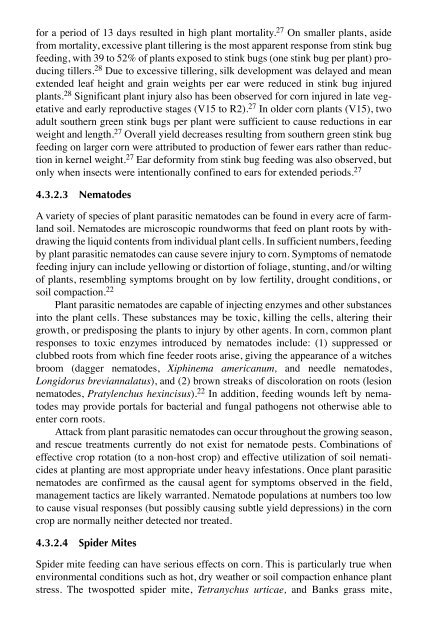Biotic Stress and Yield Loss
Biotic Stress and Yield Loss
Biotic Stress and Yield Loss
- No tags were found...
Create successful ePaper yourself
Turn your PDF publications into a flip-book with our unique Google optimized e-Paper software.
for a period of 13 days resulted in high plant mortality. 27 On smaller plants, asidefrom mortality, excessive plant tillering is the most apparent response from stink bugfeeding, with 39 to 52% of plants exposed to stink bugs (one stink bug per plant) producingtillers. 28 Due to excessive tillering, silk development was delayed <strong>and</strong> meanextended leaf height <strong>and</strong> grain weights per ear were reduced in stink bug injuredplants. 28 Significant plant injury also has been observed for corn injured in late vegetative<strong>and</strong> early reproductive stages (V15 to R2). 27 In older corn plants (V15), twoadult southern green stink bugs per plant were sufficient to cause reductions in earweight <strong>and</strong> length. 27 Overall yield decreases resulting from southern green stink bugfeeding on larger corn were attributed to production of fewer ears rather than reductionin kernel weight. 27 Ear deformity from stink bug feeding was also observed, butonly when insects were intentionally confined to ears for extended periods. 274.3.2.3 NematodesA variety of species of plant parasitic nematodes can be found in every acre of farml<strong>and</strong>soil. Nematodes are microscopic roundworms that feed on plant roots by withdrawingthe liquid contents from individual plant cells. In sufficient numbers, feedingby plant parasitic nematodes can cause severe injury to corn. Symptoms of nematodefeeding injury can include yellowing or distortion of foliage, stunting, <strong>and</strong>/or wiltingof plants, resembling symptoms brought on by low fertility, drought conditions, orsoil compaction. 22Plant parasitic nematodes are capable of injecting enzymes <strong>and</strong> other substancesinto the plant cells. These substances may be toxic, killing the cells, altering theirgrowth, or predisposing the plants to injury by other agents. In corn, common plantresponses to toxic enzymes introduced by nematodes include: (1) suppressed orclubbed roots from which fine feeder roots arise, giving the appearance of a witchesbroom (dagger nematodes, Xiphinema americanum, <strong>and</strong> needle nematodes,Longidorus breviannalatus), <strong>and</strong> (2) brown streaks of discoloration on roots (lesionnematodes, Pratylenchus hexincisus). 22 In addition, feeding wounds left by nematodesmay provide portals for bacterial <strong>and</strong> fungal pathogens not otherwise able toenter corn roots.Attack from plant parasitic nematodes can occur throughout the growing season,<strong>and</strong> rescue treatments currently do not exist for nematode pests. Combinations ofeffective crop rotation (to a non-host crop) <strong>and</strong> effective utilization of soil nematicidesat planting are most appropriate under heavy infestations. Once plant parasiticnematodes are confirmed as the causal agent for symptoms observed in the field,management tactics are likely warranted. Nematode populations at numbers too lowto cause visual responses (but possibly causing subtle yield depressions) in the corncrop are normally neither detected nor treated.4.3.2.4 Spider MitesSpider mite feeding can have serious effects on corn. This is particularly true whenenvironmental conditions such as hot, dry weather or soil compaction enhance plantstress. The twospotted spider mite, Tetranychus urticae, <strong>and</strong> Banks grass mite,

















